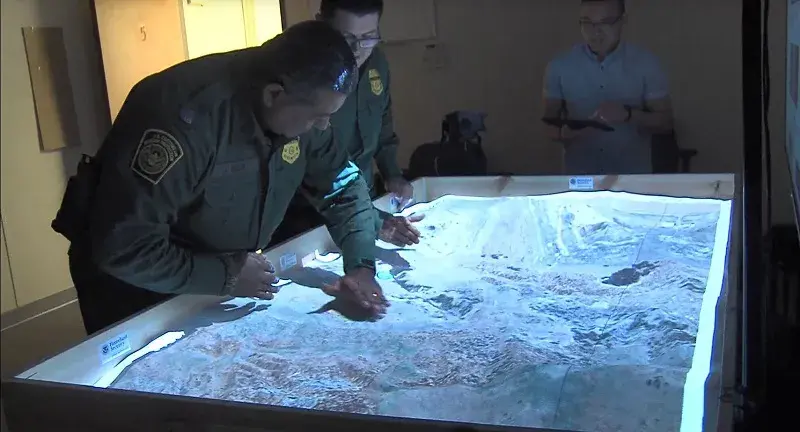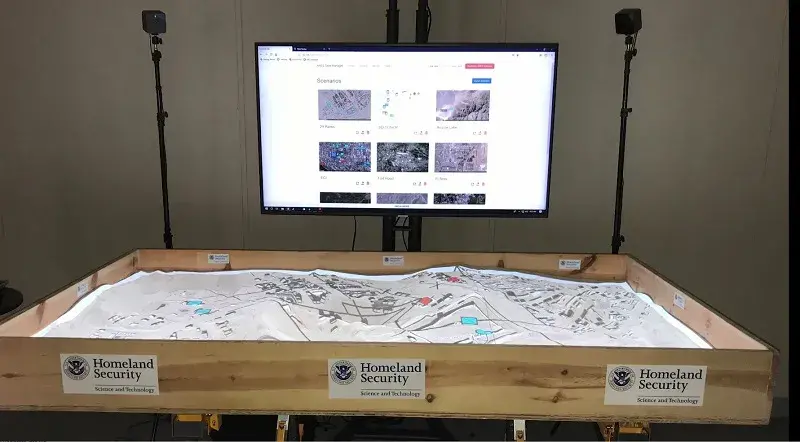Smugglers, human traffickers, undocumented immigrants and potential terrorists attempt to illegally cross our borders and enter the United States on a regular basis. The United States Border Patrol (USBP) is tasked with pursuing and apprehending these individuals before they enter the country. However, tracking groups and individuals both day and night over complex terrain can be a difficult and potentially dangerous task. Successfully apprehending individuals who do not want to be found can be extremely challenging, even with proper training and extensive experience.
 To help address this ongoing challenge and ensure USBP agents can perform their job both safely and effectively, the Department of Homeland Security (DHS) Science and Technology Directorate recently collaborated with the USBP and the Federal Law Enforcement Training Centers (FLETC) to deliver a multi-part solution by implementing innovative tools and capabilities that enable USBP agents to leverage the knowledge, skills, and abilities of expert trackers (professionals trained to detect, track, follow and apprehend potential adversaries) and use emerging technologies to maximize their tracking performance.
To help address this ongoing challenge and ensure USBP agents can perform their job both safely and effectively, the Department of Homeland Security (DHS) Science and Technology Directorate recently collaborated with the USBP and the Federal Law Enforcement Training Centers (FLETC) to deliver a multi-part solution by implementing innovative tools and capabilities that enable USBP agents to leverage the knowledge, skills, and abilities of expert trackers (professionals trained to detect, track, follow and apprehend potential adversaries) and use emerging technologies to maximize their tracking performance.
USBP agents are a crucial part of the Homeland Security Enterprise, which consists of a network of hardware, software and highly-trained individuals that work together to ensure national security.
As part of DHS’s efforts to continue improving this network of capabilities, and in turn, national security, S&T has developed, operationalized and implemented new training tools and technologies – Sign Cutting and Tracking Training, Augmented REality Sandtable (ARES), and night vision technology – to help maximize the effectiveness of USBP agents as they work to protect the U.S. border.
S&T’s Sign Cutting and Tracking Training solution consists of 2-D and 3-D training videos, a 90-minute computer-based training course, night vision technology and innovative commercial off-the-shelf augmented reality technologies that were scouted by S&T. S&T filmed the 2-D and 3-D videos along the southern border at locations in California, Arizona and Texas with expert trackers and then developed instructional content for a computer-based training course that teaches agents how to identify visual signs of human activity across different terrain, environments and times of the day. The Sign Cutting and Tracking Training solution then leverages night vision, augmented reality technology and virtual reality technologies to increase situational awareness in order to further enhance how to accurately identify and track the movement (also known as “sign cutting”) of individuals and groups along the border.
The effectiveness and operational impact of the Sign Cutting and Tracking Training solution was recently demonstrated during a Post Transition Performance Assessment conducted at the USBP Academy. In this assessment, two groups of newly-hired border patrol agents were given either the legacy sign cutting and tracking instruction, or the new S&T developed computer-based training during that two hour period. Both groups then went out into the field for their practical exercises to demonstrate their skills in “tracking boxes” that instructors used to assess their tracking performance. Those agents that trained using S&T’s new Sign Cutting and Tracking Training solution performed 63 percent better than agents who received the legacy classroom instruction.
As part of efforts to expand and enhance the Sign Cutting Tracking Training solution, S&T is also implementing multiple virtual reality and Augmented REality Sandtable (ARES) technologies. Originally developed by the U.S. Army, S&T has repurposed the ARES technology to increase situation awareness in bot training and operations; enhance USBP and FLETC training; conduct mission pre-planning/pre-briefing; conduct operational exercises; allocate deployment of resources; enhance after action review; and improve real-time decision making and mitigation of risk during field operations.
 ARES is an interactive digital sand table that uses augmented reality and/or virtual reality technology to create a 3D map of any given terrain. It uses uses a projector to display a topographical map of the desired environment on top of sand in a large sandbox, on the floor in larger spaces, or in a virtual or augmented reality environment. The sand projection uses a motion sensor that keeps track of changes a user makes in the shifting or layout of the sand and then appropriately adjusts the computer-generated terrain projection to match the sand. ARES serves as a low-cost solution that gives USBP the capability to dynamically create terrain for a specific area of interest, visualize lines of sight and overlay different types of maps to create a 3-D hologram. The ARES floor-projected version can be used for briefing larger groups, as well as a virtual reality version for individuals. All of these variations can even be networked together for coordination of exercises or operations in different locations. In some cases, the virtual reality versions of ARES are being transitioned to remote locations where staff are not able to access a physical sand table or floor projection. S&T is exploring other potential uses of the ARES technology in wildland firefighting, evacuation planning and execution as well as search and rescue and emergency management operations.
ARES is an interactive digital sand table that uses augmented reality and/or virtual reality technology to create a 3D map of any given terrain. It uses uses a projector to display a topographical map of the desired environment on top of sand in a large sandbox, on the floor in larger spaces, or in a virtual or augmented reality environment. The sand projection uses a motion sensor that keeps track of changes a user makes in the shifting or layout of the sand and then appropriately adjusts the computer-generated terrain projection to match the sand. ARES serves as a low-cost solution that gives USBP the capability to dynamically create terrain for a specific area of interest, visualize lines of sight and overlay different types of maps to create a 3-D hologram. The ARES floor-projected version can be used for briefing larger groups, as well as a virtual reality version for individuals. All of these variations can even be networked together for coordination of exercises or operations in different locations. In some cases, the virtual reality versions of ARES are being transitioned to remote locations where staff are not able to access a physical sand table or floor projection. S&T is exploring other potential uses of the ARES technology in wildland firefighting, evacuation planning and execution as well as search and rescue and emergency management operations.
Finally, S&T is delivering night vision technology to FLETC, to enhance their capabilities in developing night tracking skills. This technology will serve as a valuable tool for FLETC to use as part of their Backcountry Tactical Tracking Training Program, which develops agent and officer skills in tracking as part of missions to ensure border security, counter human and drug trafficking, capture fugitives, and conduct search and rescue operations.
“One of the most prevalent challenges in law enforcement response is operating during hours of darkness,” said Scott Glisson, Senior Instructor for Tracking, Land Navigation and Field Skills, FLETC. Through the use of night vision technology S&T is transitioning, officers and agents will have the ability to exceed the human limitations imposed during night time operations. Officer and agent response times can be measurably reduced with the use of this tech and their operational safety is also enhanced by giving them tactical advantage over potential suspects.”
S&T deployed and transitioned two ARES sandtables, a virtual reality system and the Sign Cutting and Tracking Training solution with full 3D capabilities to the USBP Yuma Sector Headquarters on October 21, 2019. S&T will also be deploying and transitioning these tools, along with night vision technology, to FLETC’s training centers in Glynco/Brunswick, Georgia, and Artesia, New Mexico. The capabilities of these tools and technologies will ensure USBP, FLETC and the agents and officers they train will be able to maximize their performance and have immediate and ongoing access to cutting edge, top-of-the-line solutions.
“The new and improved Sign Cutting and Tracking Training solution, ARES and the night vision technology are just a couple examples of solutions being delivered by S&T to enhance national security, and are resulting in measurable performance impacts,” said DHS S&T Program Manager Darren P. Wilson. “When combined with 3-D video capabilities and computer-based training course content, these technologies enable USBP and FLETC to maximize the knowledge, skills and abilities of agents and officers who are tasked with identifying and tracking activity along the border, enforcing immigration laws, countering drug and human trafficking, pursuing fugitives and conducting search and rescue operations.”
To learn more about S&T’s Sign Cutting and Tracking Training solution, watch our short video. To learn more about ARES, watch the U.S. Army Simulation and Training Technology Center’s video. For general questions, send an email to first.responder@dhs.gov.
